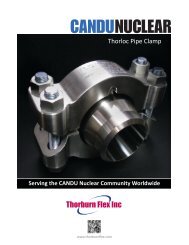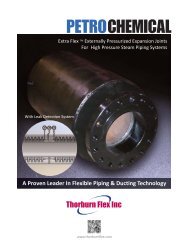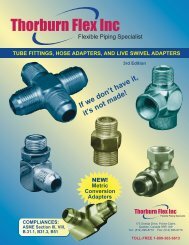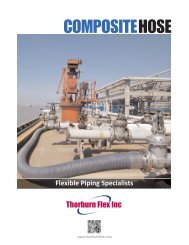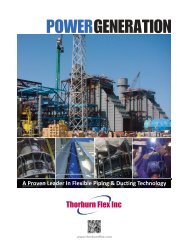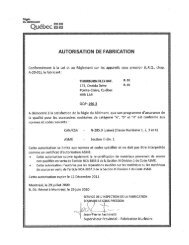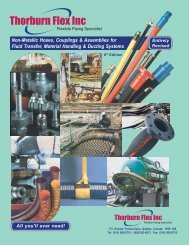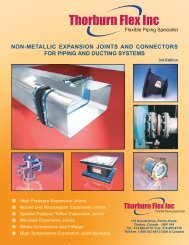Metallic Expansion Joints - Thorburn Flex Inc
Metallic Expansion Joints - Thorburn Flex Inc
Metallic Expansion Joints - Thorburn Flex Inc
You also want an ePaper? Increase the reach of your titles
YUMPU automatically turns print PDFs into web optimized ePapers that Google loves.
THORBURN<br />
FLEXIBLE PIPING SPECIALIST<br />
WHY USE THORBURN'S METAL BELLOWS<br />
TYPE EXPANSION JOINTS?<br />
All piping or ducting systems are subjected to changes in their geometry due to various factors, some of which are:<br />
a) Thermal:<br />
i.e. • Startup to operating temp.<br />
• Variations in ambient temp.<br />
• Emergency or fault conditions<br />
b) Pressure:<br />
i.e. • Deformation, due to constant pressure<br />
• Deformation, due to pulsating pressure<br />
• Deformation, due to vibration<br />
c) Mechanical:<br />
i.e. • Movement of other<br />
equipment<br />
• Thermal growth in<br />
other equipment<br />
Where the incorporation of sufficient natural flexibility in such a<br />
piping or ducting becomes a problem, three basic alternative<br />
solutions are open to the systems analyst.<br />
1) The expansion loop<br />
2) The slip type expansion joint<br />
3) <strong>Thorburn</strong> bellows type expansion joint<br />
1) EXPANSION LOOPS<br />
The "loop" is the oldest method of dealing with pipe movement<br />
and probably the most expensive when one considers today's<br />
high costs of material and labour. In addition, pressure drops,<br />
heat loss, high anchor loading together with the large space<br />
requirement, can make this method economically unsound for<br />
the relatively small amount of movements that can be<br />
accommodated with the pipe loop.<br />
3) HOW A THORBURN METALLIC BELLOWS WORKS<br />
<strong>Thorburn</strong>'s metallic bellows is a flexible seal. The convoluted<br />
portion of an expansion joint is designed to flex when thermal<br />
movements occur in the piping system. The number of convolutions<br />
depends upon the amount of movement the bellows must<br />
accommodate or the force that must be used to accomplish<br />
this deflection.<br />
The convoluted element must be strong enough circumferentially<br />
to withstand the line pressure of the system, yet responsive<br />
enough longitudinally to flex. The longitudinal load (pressure<br />
thrust) must then be absorbed by some other type of device.<br />
These are usually anchors, tie rods, hinges, or Gimbal structures.<br />
Pressure thrust can be calculated by multiplying the effective<br />
area shown in the catalogue by the working pressure.<br />
2) SLIP TYPE EXPANSION JOINTS<br />
Derived from the "Stuffing Box", the slip type expansion joint is<br />
an improvement on the <strong>Expansion</strong> Loop but is somewhat limited<br />
in its applications, being suitable for axial motion only. Small<br />
amounts of lateral or angular displacement will cause binding<br />
and eventually premature leakage. The design of this product is<br />
such that a regular examination and maintenance program must<br />
be introduced so that if leakage occurs, packing is tightened or<br />
replaced.<br />
In most cases the initial cost of the Slip type expansion joint<br />
greatly exceeds that of the Bellows expansion joint designed for<br />
the same application. Another factor to be considered is maintenance<br />
costs of Bellows type vs. the Slip type, as the bellows type<br />
requires no maintenance once correctly installed.<br />
Graphic illustration<br />
of <strong>Thorburn</strong>'s<br />
tied universal expansion joint<br />
BELLOWS MOVEMENTS<br />
BELLOWS TYPICAL SHAPES<br />
Types of bellows movement Principle for operation of Toroidal shape, extremely Lyre shape, pressure<br />
a bellows corrugation pressure resistant resistant and flexible<br />
Collars<br />
Axial Angular Lateral<br />
Page 5





